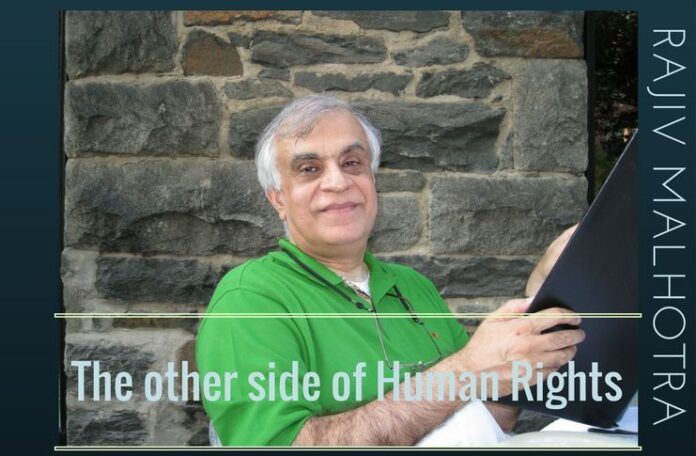
[dropcap color=”#008040″ boxed=”yes” boxed_radius=”8px” class=”” id=””]M[/dropcap]oney laundering involves channeling illegal funds through a complex web of transactions to make the money’s character increasingly ambiguous, and eventually, to pass it through lawful business activities that turn it into ‘legal’ money. Fortunately, there is a worldwide movement led by the United States to fight this.
…just as most international commerce is honest and law-abiding but can be misused to disguise unlawful activities, similarly most human rights activists and NGOs are genuinely engaged in good work, but the human rights ‘industry’ presents opportunities for mischief-makers who learn to ‘work the system.’
However, there is also another kind of ‘laundering’ that plays the same type of subterfuge, lacks transparency, but thrives unchallenged. I am referring to the vast network of ‘human rights’ programs and activism involving globalized NGOs (Non-Government Organizations), government programs, religious institutions, and private funding sources that promote conflict and sometimes become fronts for insurgencies and separatist movements of various kinds. One man’s terrorists are another man’s freedom fighters, and this turns into an opportunity for doublespeak.
The Nobel Peace laureate and Ulster Unionist leader David Trimble recently said: ‘One of the great curses of this world is the human rights industry. They justify terrorist acts and end up being complicit in the murder of innocent victims.’ His words drew an angry reaction from Amnesty International and Human Rights Watch, two of the world’s biggest human rights groups, with more than a million members worldwide. (The Guardian, January 29, 2004)
There are many other kinds of conflicts-of-interest which are even harder to pin down, but which nevertheless entail great abuse of the power that comes from being ‘givers’ and ‘helpers.’ For example, National Public Radio broadcast a series on widespread sexual abuses of women in famine-stricken parts of Africa. The culprits were UN employees, contractors and local volunteers who traded food for sex to desperate mothers and young women either through gross intimidation or through more ambiguous methods of ‘persuasion.’ The culprits used the ‘moral authority’ and power conferred by their position of being the ‘givers’ and ‘human rights activists’ in a fairly blatant way to violate the minds, values and bodies of the downtrodden they claimed to help.
To be clear, I believe that just as most international commerce is honest and law-abiding but can be misused to disguise unlawful activities, similarly most human rights activists and NGOs are genuinely engaged in good work, but the human rights ‘industry’ presents opportunities for mischief-makers who learn to ‘work the system.’
Thriving on ambiguity
[dropcap color=”#008040″ boxed=”yes” boxed_radius=”8px” class=”” id=””]J[/dropcap]ust as many honest businessmen can unwittingly get sucked into others’ laundering schemes, likewise many noble activists and NGOs may be unintentionally facilitating nefarious activities. However, in both the case of money laundering and the case of what I regard as ‘human rights laundering,’ there is the group of middlemen at various points of the food chain who know or should know what the ultimate result of this work will be, but who prefer to look the other way and claim innocence and ignorance.
A school building that was funded for education is also used for promoting insurgencies during off-hours.
What makes this complex is that many human rights resources and activities are of a dual-application nature: One side helps human rights but the other side of the same coin undermines the native culture or the integrity of the nation and could even be encouraging insurrections. In the case of tangible goods and technologies, there is now a well-defined concept of dual-use that refers to technologies that are both used in military and in civilian applications. Trade laws are formulated to deal with these items, often by imposing the same restrictions that would apply if they had only military applications.
Consider the following examples of dual-applications in human rights charities: A school building that was funded for education is also used for promoting insurgencies during off-hours. A vehicle funded for transporting students, patients and doctors also facilitates proselytizing. A person salaried for charity is also ‘volunteering’ for proselytizing and/or politics that would be disallowed under the terms of the grant if made public. A charitable hospital is used to preach to and convert the sick or dying, when their defenses and decision-making ability are at their lowest and when their need to trust the care provider is at its highest. An activist receiving grants, awards and visibility through foreign travel becomes famous, and then deploys this symbolic capital to promote specific geopolitical agendas linked (covertly) to the grant-award-publicity sources.
The funding agencies and NGOs who are involved typically deny any knowledge of the ‘other use’ being made of the grants or programs. And often these are very difficult charges to prove in practice. In the absence of “proof,” there has been little hue and cry over this, nor am I aware of any public-interest litigation.
Furthermore, the links are murky by their very nature: Clearly, a fat grant for charity empowers the person or organization to also do entirely ‘unrelated work’ of their own choice, but even if caught in such an act, the person would claim that this was unrelated ‘personal’ work that was done as a volunteer and nothing more.
In the absence of open debate on these issues and in the absence of transparent controls, a nexus of foreign agencies with funding power is playing a role in determining a. the definition of human rights, b. the choice of whose rights are to be fought for according to political calculations, and c. the culprits who are to be blamed. Selective outrage about human rights violations seems to conveniently match an institution’s geopolitical interests, lending a moral gloss to amoral pursuits.
Human rights and imperialism
[dropcap color=”#008040″ boxed=”yes” boxed_radius=”8px” class=”” id=””]I[/dropcap]n the 19th century, the British prosecuted Indian culture in the name of protecting the rights of common Indians: Women in Punjab were denied property rights under new British laws that claimed to save them from their own culture and this ultimately lead to today’s dowry murders. Workers were ‘protected from exploitation’ by Indian manufacturers of steel and textiles, by abolishing these industries from India and relocating them to start Britain’s Industrial Revolution. Land ownership was redistributed to British-selected zamindars, by using excuses of human rights abuses of the prior owners or rulers. The English language education replaced education in Sanskrit, Persian and local languages, in order to rid us of ‘our monstrous superstitions’ and make us ‘rational and civilized.’ Indian civil servants and babus were trained for the sake of this ‘civilizing mission’ of the Empire. In other words, we have seen the deceptive and destructive side of ‘human rights’ activism before, or rather, political exploitation in the guise of ‘human rights’ or ‘civilizing’ missions.
…today we find many Indian idealists often start out naïvely with good intentions, but eventually succumb to the international human rights industry’s lure of grants, travel, fame, the glamour of five-star events, and the reputational value and prestigious awards from being a human rights advocate.
The parallel is even stronger: The imperialists enticed many Indians as sepoys and babus working for the Empire, or else the British would not have been successful in ruling over a much larger population their own. In the same manner, today we find many Indian idealists often start out naïvely with good intentions, but eventually succumb to the international human rights industry’s lure of grants, travel, fame, the glamour of five-star events, and the reputational value and prestigious awards from being a human rights advocate. Many young Indians project this as an ornament symbolizing membership into the cool and sexy club of global culture. Some idealists are even more fundamentally ‘converted’ to Western theoretical constructs and instinctively adopt these lenses to misunderstand their own heritage. Once uprooted from their native culture, idealistic Indians become sepoys to fight against Indian culture and nation.
- Part 2: Discussion between Dr. Swamy and Rajiv Malhotra - September 10, 2017
- Dr Subramanian Swamy In Conversation with Rajiv Malhotra - July 24, 2017
- P2 – Discussing the Digestion of Yoga with a White Hindu - July 3, 2017











The activity of N G Os whether in human rights or any other field of BUSINESS must be controlled /monitored by the Govt from registration to implementation of stated programs. Spending all fund whether private, Public or foreign must be accounted for to the Govt.
If most N G Os are playing truant it indicates a somnolent, insensitive and failing Govt machinery not to mention rampant corruption.